Performance and vinyl text.
“About Now” Perla Mode, Zürich CH, 2009.
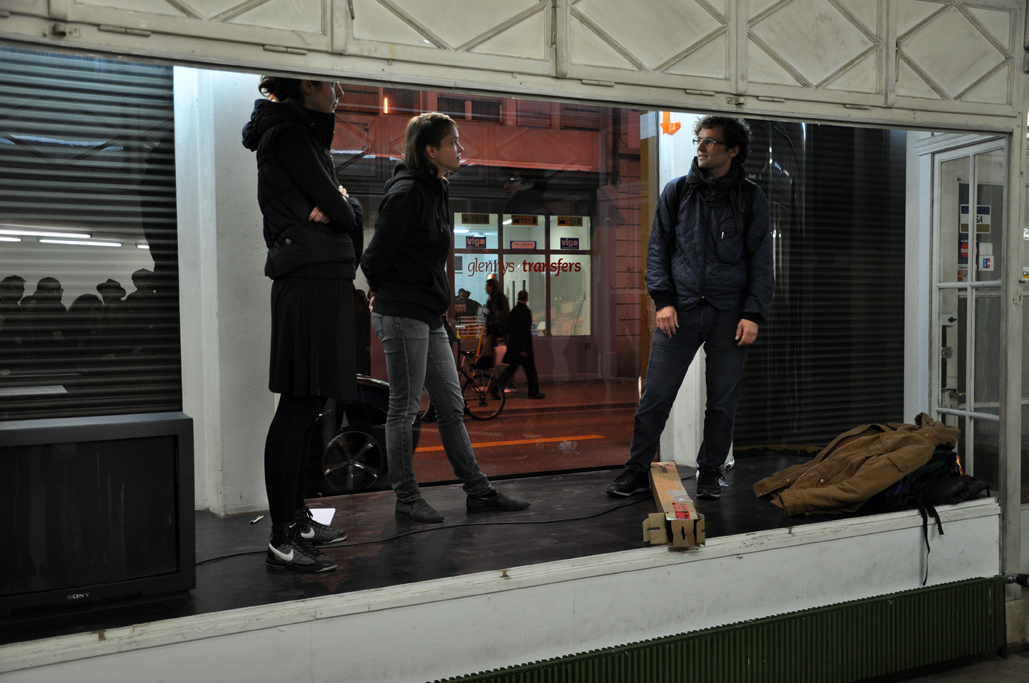
Conceived for an exhibition around the theme of instant photography, my contribution was announced as an instruction piece in which I would not be present for the installation of the text, which would be carried out at the opening by the installers. The installers would try to guess my instruction from a disorder of syllables in a package sent to the gallery weeks earlier. However, as they began to open the package holding the text, I ran into the gallery from outside, interrupting the process, and gave a short spontaneous speech about why I changed my mind, and why it was important to come up with a more meaningful statement. After deciding on a statement to be placed on the window (“handle with care”) the package was then opened, revealing that my speech had been a script.
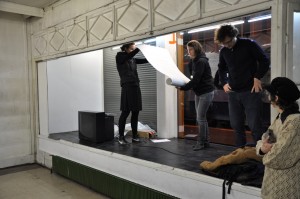
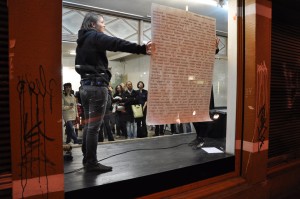
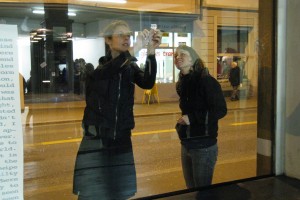
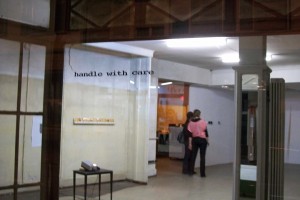
Top: interrupting the installers; ↑L: the installers opening the package; ↑R: re-reading the script after its revelation; ↓L: installing the decided text on the window; ↓R: the text as it remained on the window.
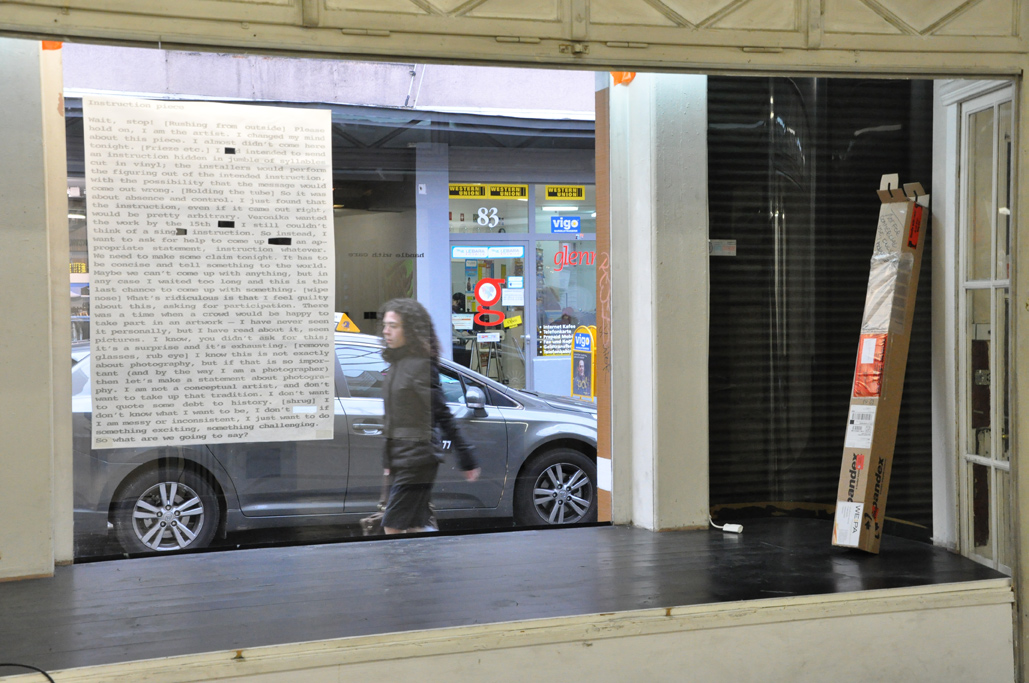
Above: the installation resulting from the performance. Below: the script.
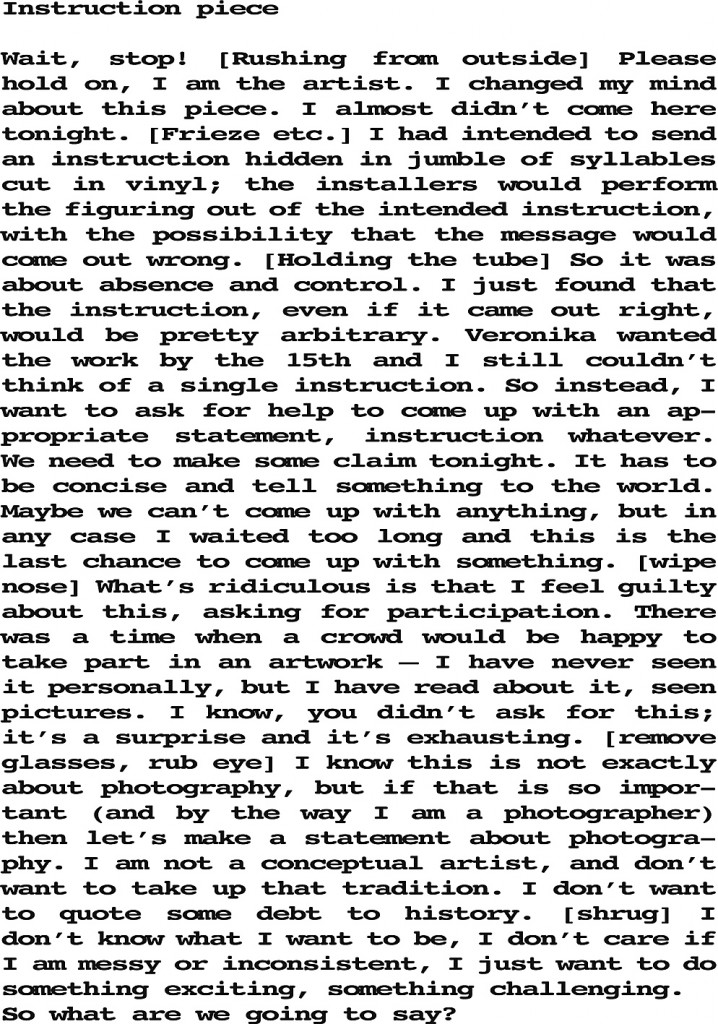
(2008, first published in Realism newspaper as part of the Free Class Frankfurt’s exhibition Trompe L’oeil Polizei at the Frankfurter Kunstverein, 2008; the below version annotated by Robert Knowles and Jon Knowles and included in the art work My other office is a bistro table by Knowles Eddy Knowles in the exhibition Making it Work at the Leonard and Bina Ellen Gallery, Montréal, 2009)
Paying heed to even wider sections of the contemporary art world one notices there is no stigma attached to collective work, except perhaps by certain collectives or critics who label it as en vogue. Or should one employ the term ‘lament’ to describe the tone of art groups come of age in the last decade or two, noting the passing from ‘independent’ to ‘institutionalized?’ Perhaps as the perennial inheritor of paradise lost, I am projecting. For something must prompt the question: “But why are collectives so attractive to the institutions nowadays?” and I simply refuse to believe the aura of authenticity exhausts the discussion as a concept or as an answer. I think it is important to look at a few of the many ways that groups operate, and the implications of these methodologies.
pdf: Presence and Absence in Crowds
(2008, published in Bookbook, Staedelschule Press, 2011)
My inbox was pretty much empty those first few weeks. Now I get messages from work. Some people (my mother) tell me that it’s okay, this isn’t nothing, it’s settling in time. I don’t argue, although I don’t pretend to endorse this view. Nothing is nothing, if you’re not doing something. Impatiently, I expend the energy pointing out to her that some of my ex-classmates are already so busy doing what they want to do that my new job is more blow than coup; she reminds me that at least I am staying healthy, aren’t I, which was part of the motive behind this move, wasn’t it. To be away from that stuff.
pdf: the-autumn-is-authority-here
(published in Fillip #5, 2007)
With its dark purple walls, broad drapery curbing outside light, and manifold corners isolating objects from each other, even the exhibition’s layout is designed to downplay itself. One must seek out titles and dates in a handout- that is, if one’s dependence on ‘metadata’ is insufferable.
pdf: Taking Down Names
Written 2009, published in Contemporary Art and Investment Magazine, 2010
A neon sign, a crooked fluorescent tube, some glass cases and abusive warnings clumsily taped on the walls; a bag of laundry and books, a case of porno DVDs, a printed out drawing, some balls of tape, a generic painting, and a plant; at first glance PAWNSHOP, a project by Anton Vidokle and Julieta Aranda, who jointly run e-flux, may appear as a handy curatorial concept, using the thematic of pawnshops to assemble a roomful of curious objects.
pdf: PAWNSHOP
(2008, published in The Book of Guilty Pleasures, edited by Song Ming An and Kim Cascone, 2011)
One night in a small roadhouse cum hostess bar in rural Russia, the Russian artist Stas Shuripa broke it all down for me: real techno no longer exists.
pdf: trance






